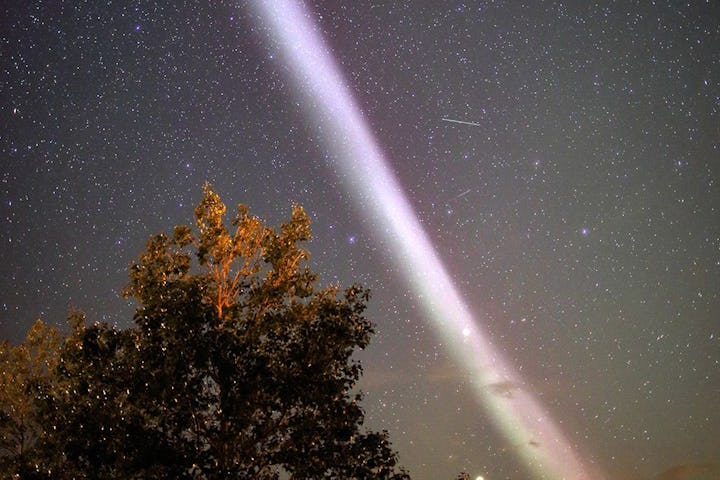Everyone Is Talking About STEVE, A Rare And Dazzling Purple "Sky Glow"
STEVE isn't an aurora borealis, but is is close.

From meteor showers to eclipses to the Northern Lights, the beauty of our world and the cosmos can feel endless. But just when you thought you’ve heard it all, there’s another sky show that will be more visible over the coming months and years. And believe it or not, that “skyglow” is called STEVE. Yes, STEVE. Here’s what you need to know.
What is STEVE?
STEVE, which stands for Strong Thermal Emission Velocity Enhancement, according to Space.com, is a “rare type of atmospheric glow.” It’s quite similar to the Northern Lights in that it can be “triggered when a stream of solar plasma interacts with Earth’s atmosphere and magnetosphere.” But this one looks very different from the famous aurora borealis.
STEVE was first discovered in 2015, according to The Washington Post, when it was spotted in Canada. This sky event was officially recognized and then formally identified in 2018. It looks like a ribbon of bright colors floating through the night sky, in gorgeous shades of pink and purple, with a “green picket fence structure” that’s often mixed in with the pinks.
“It can appear as just a short arc to the west of the aurora or extend across the full sky from east to west,” The Washington Post explains. “Large manifestations also show more depth in color — a deep red on top, mauve in the middle, and white on the bottom.”
Basically, it’s a ribbon of gorgeous colors that appears in the sky that could be confused for the Northern Lights, but they’re different.
How is STEVE different from the Northern Lights?
At first, it was believed STEVE was a variation of the Northern Lights. But when astronomers took a closer look, there were some key differences between the two phenomena.
“According to researchers at the University of Calgary in Canada and the University of California, Los Angeles, STEVE does not contain the telltale traces of charged particles blasting through Earth's atmosphere that auroras do,” LiveScience explains.
“STEVE, therefore, is not an aurora at all, but something entirely different: a mysterious, largely unexplained phenomenon that the researchers have dubbed a ‘sky glow.’”
Their findings were reported in the journal Geophysical Research Letters in August 2022.
You can tell the difference between the two when you look at their colors and size. Northern Lights are often in red, blue, and green bands. STEVE, on the other hand, are more muted reds and pinks, with purple-white light in the shape of a single ribbon that seemingly goes on forever.
How can I watch STEVE with the kids?
Similarly to the Northern Lights, STEVE can’t be viewed from everywhere. Most often, it’s easier to spot in Canada, Finland, and in some parts of the U.S., The Washington Post notes.
Just like the Northern Lights, STEVE is most often seen in March and September — around the spring and fall equinoxes. The arch of the lights tends to only be visible for about 30 minutes when the sun goes down and often before midnight.
If you’re lucky enough to be far North, you might be able to see the sky show around the equinoxes. Proving STEVE is all the rage right now, Axios also published a guide on how to find this elusive sky glow.
If you can spot STEVE in person, you can report your sighting at the citizen science project Aurorasaurus. Good luck!